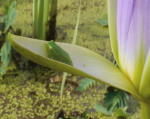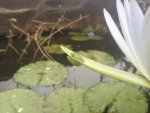-
Did you know that registered users see fewer ads? Register today!
You are using an out of date browser. It may not display this or other websites correctly.
You should upgrade or use an alternative browser.
You should upgrade or use an alternative browser.
Trying to identify East African hyperolius...
- Thread starter chura
- Start date
FrogEyes
Active member
- Joined
- Sep 5, 2010
- Messages
- 908
- Reaction score
- 41
- Points
- 28
- Location
- Southern Minnesota
- Country
- Canada
Unfortunately, I'm two weeks and 2500km from my field guides. I'm thinking it's H.pusillus, but without being able to double-check, I'm less than certain.
FrogEyes
Active member
- Joined
- Sep 5, 2010
- Messages
- 908
- Reaction score
- 41
- Points
- 28
- Location
- Southern Minnesota
- Country
- Canada
In this case, Treefrogs of Africa:
NHBS - Treefrogs of Africa - Arne Schiotz
Amphibians of East Africa:
NHBS - Amphibians of East Africa - Alan Channing and Kim M Howell
Supplement with some free online guides:
Field guide to the amphibians of the Eastern Arc Mountains and coastal forests of Tanzania and Kenya
http://www.cepf.net/Documents/bilingual_field_guide_eacf.pdf
Amphibian biodiversity in Taita Hills, Kenya
http://ubm.opus.hbz-nrw.de/volltexte/2009/1852/pdf/diss.pdf
and whatever updates might be available in terms of species revisions, descriptions, or distributions.
NHBS - Treefrogs of Africa - Arne Schiotz
Amphibians of East Africa:
NHBS - Amphibians of East Africa - Alan Channing and Kim M Howell
Supplement with some free online guides:
Field guide to the amphibians of the Eastern Arc Mountains and coastal forests of Tanzania and Kenya
http://www.cepf.net/Documents/bilingual_field_guide_eacf.pdf
Amphibian biodiversity in Taita Hills, Kenya
http://ubm.opus.hbz-nrw.de/volltexte/2009/1852/pdf/diss.pdf
and whatever updates might be available in terms of species revisions, descriptions, or distributions.
EasternNewtLove
New member
- Joined
- Sep 12, 2011
- Messages
- 265
- Reaction score
- 2
- Points
- 0
- Location
- New Hampshire
- Country
- United States
- Display Name
- Jesse
Well I looked them both up and it looks more like H. Nasutus by the head structure.
FrogEyes
Active member
- Joined
- Sep 5, 2010
- Messages
- 908
- Reaction score
- 41
- Points
- 28
- Location
- Southern Minnesota
- Country
- Canada
Field guide to the amphibians and reptiles of Arusha National Park (Tanzania)
http://www-3.unipv.it/webshi/images/files/tanzie2002.pdf
Reflections on the Hyperolius nasutus group (Anura, Hyperoliidae)
http://www.zmuc.dk/VerWeb/STAFF/Alytes(2006)24(1-4)61-71_Schiotz.pdfhttp://www-3.unipv.it/webshi/images/files/tanzie2002.pdf
Reflections on the Hyperolius nasutus group (Anura, Hyperoliidae)
Couldn't find, but probably more or less covered in the above:
Cryptic species of sharp-nosed reed frogs in the Hyperolius nasutus complex: advertisement call differences
Hi - still working with this species in Tsavo National park but had a general question re these small species of Hyperolius: Is approximate adult size attained at metamorphosis? I have seen H. pusillus ( tentative ID) with quite large tadpoles c 30mm metamorphosing into frogs c 10-15mm in length, but have not seen any frogs/ froglets longer than this. Are the frogs sexually mature within a short time of metamorphosing?
FrogEyes
Active member
- Joined
- Sep 5, 2010
- Messages
- 908
- Reaction score
- 41
- Points
- 28
- Location
- Southern Minnesota
- Country
- Canada
Most frogs I can think of grow a fair amount after metamorphosis. Some noteworthy abberations are Pseudis and Lysapsus [South American Hylidae], known as paradoxical frogs because the froglets are much smaller than the tadpoles. They subsequently grow larger. Another is certain species of Scinax [I think - also South American Hylidae], which reach sexual maturity before they completely lose their tails - neoteny is unknown in Anura, but this could be considered a transient example. I suspect that the small green Hyperolius also mature very quickly and grow very little, as they're rather small frogs anyway. That species group has been recently revised; that revision plus "Treefrogs of Africa" might be your best starting points. I don't have either handy, but may have a chance to look at both by the end of the week. They MAY contain some information on transformation and maturation sizes. I would not be surprised if the adult frogs are more secretive. It's often the case that recent metamorphs are extremely numerous near the water, before they are eaten, while the adults stay hidden away and inconspicuous.
FrogEyes
Active member
- Joined
- Sep 5, 2010
- Messages
- 908
- Reaction score
- 41
- Points
- 28
- Location
- Southern Minnesota
- Country
- Canada
Try these [Google search of 'Hyperolius nasustus pdf', if the links don't work], as they may at least give you some clues:
www.landesmuseum.at/pdf_frei.../HER_19_1_2_0003-0012.pdf
www.zmuc.dk/VerWeb/.../Alytes(2006)24(1-4)61-71_Schiotz.pdf
Cryptic species of sharp-nosed re... preview & related info | Mendeley
www.mapress.com/zootaxa/2012/f/z03269p017f.pdf
I don't have the last of those, do have the first two, and probably have the third.
www.landesmuseum.at/pdf_frei.../HER_19_1_2_0003-0012.pdf
www.zmuc.dk/VerWeb/.../Alytes(2006)24(1-4)61-71_Schiotz.pdf
Cryptic species of sharp-nosed re... preview & related info | Mendeley
www.mapress.com/zootaxa/2012/f/z03269p017f.pdf
I don't have the last of those, do have the first two, and probably have the third.
I am sure you are right about the large numbers of newly metamorphosed froglets - I've seen the same thing with P. edulis dispersing - when there can be thousands one day with lots of birds etc eating them and they can disappear almost overnight.
I include a picture of the newly metamorphosed froglets (total length c 10mm). What made me ask about size at sexual maturity was that when we added some water to the pan ( a shallow depression in granite bedrock) then there was some rather lack-lustre calling. Unfortunately we couldn't stay until evening to see if it developed but I assume there is no point in calling ( and potentially attracting unwelcome attention from a predator) unless there is a possibility of mating (?) and therefore being sexually mature.
I include a picture of the newly metamorphosed froglets (total length c 10mm). What made me ask about size at sexual maturity was that when we added some water to the pan ( a shallow depression in granite bedrock) then there was some rather lack-lustre calling. Unfortunately we couldn't stay until evening to see if it developed but I assume there is no point in calling ( and potentially attracting unwelcome attention from a predator) unless there is a possibility of mating (?) and therefore being sexually mature.
Attachments
FrogEyes
Active member
- Joined
- Sep 5, 2010
- Messages
- 908
- Reaction score
- 41
- Points
- 28
- Location
- Southern Minnesota
- Country
- Canada
Annnnd...were they REALLY P.edulis? With P.angusticeps revalidated, that might require re-confirmationI am sure you are right about the large numbers of newly metamorphosed froglets - I've seen the same thing with P. edulis dispersing - when there can be thousands one day with lots of birds etc eating them and they can disappear almost overnight.
FrogEyes
Active member
- Joined
- Sep 5, 2010
- Messages
- 908
- Reaction score
- 41
- Points
- 28
- Location
- Southern Minnesota
- Country
- Canada
Of relevance here - published tomorrow: a revision of the Hyperolius nasutus group, with descriptions of six new species (subscription access):
A. CHANNING, A. HILLERS, S. LÖTTERS, M.-O. RÖDEL, S. SCHICK, W. CONRADIE, D. RÖDDER, V. MERCURIO, P. WAGNER, J.M. DEHLING, L.H. DU PREEZ, J. KIELGAST10 & M. BURGER, 2013. Taxonomy of the super-cryptic Hyperolius nasutus group of long reed frogs of Africa (Anura: Hyperoliidae), with descriptions of six new species. Zootaxa 3620 (3): 301–350.
Zootaxa 3620 (3); List of papers
A. CHANNING, A. HILLERS, S. LÖTTERS, M.-O. RÖDEL, S. SCHICK, W. CONRADIE, D. RÖDDER, V. MERCURIO, P. WAGNER, J.M. DEHLING, L.H. DU PREEZ, J. KIELGAST10 & M. BURGER, 2013. Taxonomy of the super-cryptic Hyperolius nasutus group of long reed frogs of Africa (Anura: Hyperoliidae), with descriptions of six new species. Zootaxa 3620 (3): 301–350.
Zootaxa 3620 (3); List of papers
Abstract
Specimens from across the range of the Hyperolius nasutus species group were sequenced for two mitochondrial genes and one nuclear gene. Advertisement calls were recorded from the same specimens where possible, and morphological characters were compared. Bayesian inference and maximum likelihood produced a tree indicating 16 clades. The clades show little or no overlap in combinations of 16S sequence difference, shared tyr haplotypes, advertisement call parameters, snout profiles and webbing. On the basis of these data we recognise H. acuticeps, H. adspersus, H. benguellensis, H. dartevellei, H. igbettensis, H. nasutus, H. nasicus, H. poweri, H. viridis and describe six new species: Hyperolius friedemanni sp. nov. Mercurio & Rödel, Hyperolius howelli sp. nov. Du Preez & Channing, Hyperolius inyangae sp. nov. Channing, Hyperolious jacobseni sp. nov. Channing, Hyperolius rwandae sp. nov. Dehling, Sinsch, Rödel & Channing, and Hyperolius lupiroensis sp. nov. Channing. Hyperolius lamottei is confirmed to be outside the H. nasutus group clade. Hyperolius granulatus, H. oxyrhynchus, H. punctulatus and H. sagitta are assigned as junior synonyms. As our results are based on a small number of specimens, these hypotheses await testing with larger sample sizes and more characters. A species distribution model suggests where outlier populations might be found.
General chit-chat
- No one is chatting at the moment.
-
Clareclare:Would Chinese fire belly newts be more or less inclined towards an aquatic eft set up versus Japanese . I'm raising them and have abandoned the terrarium at about 5 months old and switched to the aquatic setups you describe. I'm wondering if I could do this as soon as they morph?+1


